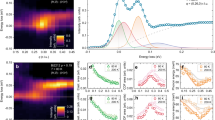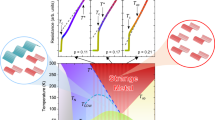Abstract
The electronic properties of cuprate high-temperature superconductors in their normal state are highly two-dimensional: transport along the crystal planes is perfectly metallic, but is insulating along the perpendicular ‘c-axis’ direction. The ratio of the in-plane to the perpendicular resistance can exceed 104 (refs 1,2,3,4). This anisotropy was identified as one of the mysteries of the cuprates early on5,6, and although widely different proposals exist for its microscopic origin7,8,9, there is little empirical information on the microscopic scale. Here, we elucidate the properties of the insulating layers with a newly developed scanning noise spectroscopy technique that can spatially map the current and its time-resolved fluctuations. We discover atomic-scale noise centres that exhibit megahertz current fluctuations 40 times the expectation from Poissonian noise, more than what has been observed in mesoscopic systems10. Such behaviour can happen only in highly polarizable insulators and represents strong evidence for trapping of charge in the charge reservoir layers. Our measurements suggest a picture of metallic layers separated by polarizable insulators within a three-dimensional superconducting state.
This is a preview of subscription content, access via your institution
Access options
Access Nature and 54 other Nature Portfolio journals
Get Nature+, our best-value online-access subscription
$29.99 / 30 days
cancel any time
Subscribe to this journal
Receive 12 print issues and online access
$209.00 per year
only $17.42 per issue
Buy this article
- Purchase on Springer Link
- Instant access to full article PDF
Prices may be subject to local taxes which are calculated during checkout




Similar content being viewed by others
Data availability
The data that support the plots within this paper and other findings of this study are available from the corresponding author upon reasonable request.
References
Watanabe, T., Fujii, T. & Matsuda, A. Anisotropic resistivities of precisely oxygen controlled single-crystal Bi2Sr2CaCu2O8+δ: Systematic study on ‘spin gap’ effect. Phys. Rev. Lett. 79, 2113–2116 (1997).
Sordi, G., Sémon, P., Haule, K. & Tremblay, A. M. S. C-axis resistivity, pseudogap, superconductivity, and Widom line in doped Mott insulators. Phys. Rev. B 87, 041101(R) (2013).
Levallois, J. et al. Temperature-dependent ellipsometry measurements of partial Coulomb energy in superconducting cuprates. Phys. Rev. X 6, 031027 (2016).
Kim, J. H. et al. Strong damping of the c-axis plasmon in high-T c cuprate superconductors. Physica C 247, 297–308 (1995).
Anderson, P. W. Experimental constraints on the theory of high-T c superconductivity. Science 256, 1526–1531 (1992).
Leggett, A. J. A. ‘midinfrared’ scenario for cuprate superconductivity. Proc. Natl Acad. Sci. USA 96, 8365–8372 (1999).
Gutman, D. B. & Maslov, D. L. Anomalous c-axis transport in layered metals. Phys. Rev. Lett. 99, 196602 (2007).
Johnston, S. et al. Systematic study of electron–phonon coupling to oxygen modes across the cuprates. Phys. Rev. B 82, 064513 (2010).
Meevasana, W., Devereaux, T. P., Nagaosa, N., Shen, Z. X. & Zaanen, J. Calculation of overdamped c-axis charge dynamics and the coupling to polar phonons in cuprate superconductors. Phys. Rev. B 74, 174524 (2006).
Blanter, Y. M. in CFN Lectures on Functional Nanostructures Vol. 2 (eds Vojta, M., Röthig, C. & Schön, G.) Ch. 3 (Springer, Berlin, Heidelberg, 2010)
Anderson, P. W. & Zou, Z. ‘Normal’ tunneling and ‘normal’ transport: Diagnostics for the resonating-valence-bond state. Phys. Rev. Lett. 60, 132–135 (1988).
Moses, P. & Mc Kenzie, R. H. Comparison of coherent and weakly incoherent transport models for the interlayer magnetoresistance of layered Fermi liquids. Phys. Rev. B 60, 7998–8011 (1999).
Markiewicz, R. S., Sahrakorpi, S., Lindroos, M., Lin, H. & Bansil, A. One-band tight-binding model parametrization of the high-T c cuprates including the effect of k z dispersion. Phys. Rev. B 72, 54519 (2005).
de-Picciotto, R. et al. Direct observation of a fractional charge. Nature 389, 162–164 (1997).
Ronen, Y. et al. Charge of a quasiparticle in a superconductor. Proc. Natl Acad. Sci. USA 113, 1743–1748 (2016).
van den Brom, H. & van Ruitenbeek, J. Quantum suppression of shot noise in atom-size metallic contacts. Phys. Rev. Lett. 82, 1526–1529 (1999).
Blanter, Y. M. & Büttiker, M. Transition from sub-Poissonian to super-Poissonian shot noise in resonant quantum wells. Phys. Rev. B 59, 10217–10226 (1999).
Birk, H., Jong, M., De & Schönenberger, C. Shot-noise suppression in the single-electron tunneling regime. Phys. Rev. Lett. 75, 1610–1613 (1995).
Kemiktarak, U., Ndukum, T., Schwab, K. C. & Ekinci, K. L. Radio-frequency scanning tunnelling microscopy. Nature 450, 85–88 (2007).
Burtzlaff, A., Schneider, N. L., Weismann, A. & Berndt, R. Shot noise from single atom contacts in a scanning tunneling microscope. Surf. Sci. 643, 10–12 (2016).
Sung, M. G. et al. Scanning noise microscopy on graphene devices. ACS Nano 5, 8620–8628 (2011).
DiCarlo, L. et al. System for measuring auto- and cross correlation of current noise at low temperatures. Rev. Sci. Instrum. 77, 073906 (2006).
Keimer, B., Kivelson, S. A., Norman, M. R., Uchida, S. & Zaanen, J. From quantum matter to high-temperature superconductivity in copper oxides. Nature 518, 179–186 (2015).
Carlson, E. W., Dahmen, K. A., Fradkin, E. & Kivelson, S. A. Hysteresis and noise from electronic nematicity in high-temperature superconductors. Phys. Rev. Lett. 96, 097003 (2006).
Kivelson, S. A., Bindloss, I. P., Fradkin, E. & Oganesyan, V. How to detect fluctuating stripes in the high-temperature superconductors. Rev. Mod. Phys. 75, 1201–1241 (2003).
Zhang, J. et al. Discovery of slow magnetic fluctuations and critical slowing down in the pseudogap phase of YBa2Cu3Oy. Sci. Adv. 4, 5235 (2018).
Choubey, P., Kreisel, A., Berlijn, T., Andersen, B. M. & Hirschfeld, P. J. Universality of scanning tunneling microscopy in cuprate superconductors. Phys. Rev. B 96, 174523 (2017).
Martin, I., Balatsky, A. V. & Zaanen, J. Impurity states and interlayer tunneling in high temperature superconductors. Phys. Rev. Lett. 88, 097003 (2002).
Onac, E., Balestro, F., Trauzettel, B., Lodewijk, C. F. J. & Kouwenhoven, L. P. Shot-noise detection in a carbon nanotube quantum dot. Phys. Rev. Lett. 96, 026803 (2006).
Thielmann, A., Hettler, M. H., Konig, J. & Schon, G. Cotunneling current and shot noise in quantum dots. Phys. Rev. Lett. 95, 146806 (2005).
Safonov, S. S. et al. Enhanced shot noise in resonant tunneling via Interacting localized states. Phys. Rev. Lett. 91, 136801 (2003).
Gustavsson, S. et al. Counting statistics and super-Poissonian noise in a quantum dot: Time-resolved measurements of electron transport. Phys. Rev. B 74, 195305 (2006).
Zeljkovic, I. et al. Imaging the impact of single oxygen atoms on superconducting Bi2+ySr2−yCaCu2O8+x. Science 337, 320–323 (2012).
Tsvetkov, A. A. et al. Global and local measures of the intrinsic Josephson coupling in Tl2Ba2CuO6 as a test of the interlayer tunneling model. Nature 395, 360–362 (1998).
Reyen, N. et al. Superconducting interface between insulating oxides. Science 317, 1196–1199 (2007).
Wang, Q. Y. et al. Interface-induced high-temperature superconductivity in single unit-cell FeSe films on SrTiO3. Chin. Phys. Lett. 29, 037402 (2012).
Lee, J. J. et al. Interfacial mode coupling as the origin of the enhancement of T c in FeSe films on SrTiO3. Nature 515, 245–248 (2014).
Kinoda, G. et al. Direct determination of localized impurity levels located in the blocking layers of Bi2Sr2CaCu2Oy using scanning tunneling microscopy/spectroscopy. Phys. Rev. B 71, 020502(R) (2005).
Fei, Y. et al. Electronic effect of doped oxygen atoms in Bi2201 superconductors determined by scanning tunneling microscopy. Preprint at https://arXiv.org/abs/1803.03400 (2018).
Dong, Q. et al. Ultra-low noise high electron mobility transistors for high-impedance and low-frequency deep cryogenic readout electronics. Appl. Phys. Lett. 105, 013504 (2014).
Bastiaans, K. M. et al. Amplifier for scanning tunneling microscopy at MHz frequencies. Preprint at https://arXiv.org/abs/1806.00374 (2018).
Acknowledgements
We thank C. Beenakker, A. Ben Hamida, Y. Blanter, D. Chatzopoulos, V. Cheianov, T. Klapwijk, M. Leeuwenhoek and J. van Ruitenbeek for help and valuable discussions. This project was financially supported by the European Research Council (ERC StG SpinMelt) and by the Netherlands Organisation for Scientific Research (NWO/OCW), as part of the Frontiers of Nanoscience programme, as well as through a Vidi grant (680-47-536).
Author information
Authors and Affiliations
Contributions
K.M.B, D.C., T.B, I.B. and M.P.A. designed, developed and performed the noise-spectroscopy STM experiments and analysed the data, Y.H. and M.S.G. created the samples, Q.D. and J.Y. constructed the HEMT. M.P.A. supervised the study. All authors contributed to the interpretation of the data.
Corresponding author
Ethics declarations
Competing interests
The authors declare no competing interests.
Additional information
Publisher’s note: Springer Nature remains neutral with regard to jurisdictional claims in published maps and institutional affiliations.
Supplementary information
Supplementary information
Supplementary Figures 1–9; Supplementary References 1–7
Rights and permissions
About this article
Cite this article
Bastiaans, K.M., Cho, D., Benschop, T. et al. Charge trapping and super-Poissonian noise centres in a cuprate superconductor. Nature Phys 14, 1183–1187 (2018). https://doi.org/10.1038/s41567-018-0300-z
Received:
Accepted:
Published:
Issue Date:
DOI: https://doi.org/10.1038/s41567-018-0300-z



